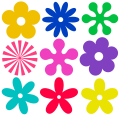| Part of the Counterculture of the 1960s and the hippie movement | |
 Spencer Dryden, Marty Balin, and Paul Kantner of Jefferson Airplane performing at the Fantasy Fair, early June 1967 | |
| Date | 1967 |
|---|---|
| Location | Haight-Ashbury, Golden Gate Park, San Francisco |
| Participants | ~100,000 (estimated) |
| Outcome |
|
The Summer of Love was a major social phenomenon that occurred in San Francisco during the summer of 1967. As many as 100,000 people, mostly young people, hippies, beatniks, and 1960s counterculture figures, converged in San Francisco's Haight-Ashbury district and Golden Gate Park. [1] [2]
Contents
- Background
- Culture of San Francisco
- Human Be-In and inspiration
- Planning
- Beginning
- Youth arrivals
- Popularization
- "San Francisco (Be Sure to Wear Flowers in Your Hair)"
- The Diggers
- Events
- New York City
- California
- Denver
- Use of drugs
- Funeral and aftermath
- Legacy
- Second Summer of Love
- Soviet "Flower Children"
- 40th anniversary
- 50th anniversary
- See also
- References
- Further reading
- External links
More broadly, the Summer of Love encompassed hippie culture, spiritual awakening, hallucinogenic drugs, anti-war sentiment, and free love throughout the West Coast of the United States, and as far away as New York City. [3] [4] An episode of the PBS documentary series American Experience referred to the Summer of Love as "the largest migration of young people in the history of America". [5]
Hippies, sometimes called flower children, were an eclectic group. Many opposed the Vietnam War, were suspicious of government, and rejected consumerist values. In the United States, counterculture groups rejected suburbia and the American way and instead opted for a communal lifestyle. Some hippies were active in political organization, whereas others were passive and more concerned with art (music, painting, poetry in particular) or spiritual and meditative practices. [4] Many hippies took interest in ancient Indian religions, such as Hinduism and Buddhism.





